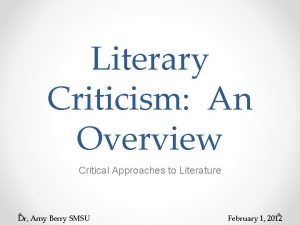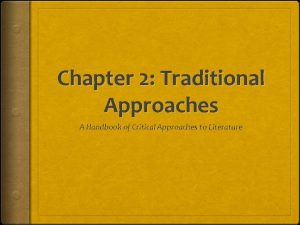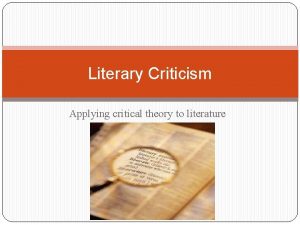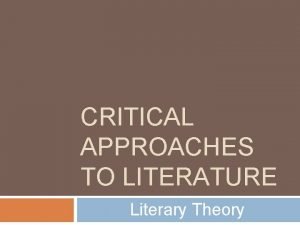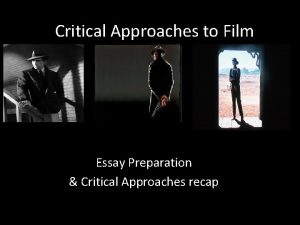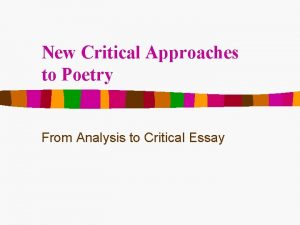Quiz 1 New Critical Approaches to Poetry 1











- Slides: 11

Quiz (1): New Critical Approaches to Poetry

(1) What of the following could be the two major categories to divide up the critical approaches? n 1. Surface and symbolic meanings; n 2. Intrinsic and Extrinsic Approaches; n 3. Sociological and Psychological Approaches. n

(2) n n “This Is Just to Say”: What is/are the Central Opposition(s) in this poem? 1. Breakfast v. s. Dessert; 2. Plum v. s. Icebox; 3. Sweet v. s. Delicious.

(3) n n n “The poet wants to use this poem to get a divorce, so this poem is about divorce. ” This is an example of: 1. Affective Fallacy; 2. Intentional Fallacy; 3. Faulty Deduction.

(4) n n What is the Central Opposition in “Stella’s Birthday”? 1. Stella and the speaker; 2. Body and Mind; 3. Double and split.

(5) n n n What in the following is not part of the major principles of New Criticism? 1. Affective Fallacy; 2. Orgasm; 3. Organic Unity; 4. Autonomy.

(1) Answer What of the following could be the two major categories to divide up the critical approaches? n 1. Surface and symbolic meanings; n 2. Intrinsic and Extrinsic Approaches; n 3. Sociological and Psychological Approaches. n

(2) Answer n n “This Is Just to Say”: What is/are the Central Opposition(s) in this poem? 1. Breakfast v. s. Dessert; 2. Plum v. s. Icebox; (or Sweet v. s. Cold) 3. Sweet v. s. Delicious.

(3) Answer n n n “The poet wants to use this poem to get a divorce, so this poem is about divorce. ” This is an example of: 1. Affective Fallacy; 2. Intentional Fallacy; 3. Faulty Deduction.

(4) Answer n n What is the Central Opposition in “Stella’s Birthday”? 1. Stella and the speaker; 2. Body and Mind; 3. Double and split.

(5) Answer n n n What in the following is not part of the major principles of New Criticism? 1. Affective Fallacy; 2. Orgasm; 3. Organic Unity; 4. Autonomy.
 Critical approaches to poetry
Critical approaches to poetry Applying critical approaches to literary analysis
Applying critical approaches to literary analysis Formalistic approach in literature
Formalistic approach in literature Critical semi critical and non critical instruments
Critical semi critical and non critical instruments Semi critical instruments in dentistry
Semi critical instruments in dentistry A handbook of critical approaches to literature
A handbook of critical approaches to literature Criticism of critical theory
Criticism of critical theory Outline critical approaches to interpreting text
Outline critical approaches to interpreting text Applying critical approaches to literary analysis
Applying critical approaches to literary analysis Compare non-critical readers with critical readers.
Compare non-critical readers with critical readers. Human resources today
Human resources today New approaches to organizing hr
New approaches to organizing hr

